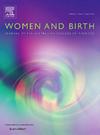评估引产改善对临床结果、妇女护理满意度和临床医生经验的影响
IF 4.1
2区 医学
Q1 NURSING
引用次数: 0
摘要
背景:全球人工引产率持续上升。临床医生对人工晶状体的建议各不相同,往往是由于不确定性或风险规避所致。有证据表明,改进指南和实践可以支持临床医生的人工晶状体决策,并支持妇女做出明智的选择,并有积极的人工晶状体经验。在澳大利亚一家妇产医院实施了一项人工晶状体改善倡议,包括循证指南和人工晶状体联络助产士。目的通过检查临床结果、对新的人工晶状体指南的依从性、妇女的护理满意度和临床医生的经验来评估人工晶状体改善计划的结果。方法采用多方法评估,包括:回顾性审核医疗记录以确定人工晶状体术前/术后的发生率和原因(n = 2676),对妇女进行调查(n = 100)和访谈(n = 48),以及临床医生焦点小组或访谈(n = 23)。术后人工晶状体成形率显著降低5 %(43.3% % vs 38.6 %;p & lt; 0.01)。人工晶状体的适应症也发生了显著变化,由于新指南中不再推荐的原因而进行人工晶状体植入的妇女减少了。调查结果显示,超过一半的女性不知道为什么(54% %)或如何(36% %)进行人工晶状体植入。定性数据表明,与人工晶状体联络助产士的讨论提高了妇女对人工晶状体的理解和期望。临床医生的反馈强调了工作流程的改进和人工晶状体推荐的合理性。结论该倡议对人工晶状体植入术的发生率、原因、妇女和临床医生的经验均有积极影响。有必要在其他产妇环境中实施。本文章由计算机程序翻译,如有差异,请以英文原文为准。
Evaluating the impact of the induction of labour improvement initiative on clinical outcomes, women’s care satisfaction, and clinician experiences
Background
Rates of induction of labour (IOL) continue to rise globally. Clinician recommendations for IOL vary and are often driven by uncertainty or risk aversion. Evidence suggests that improving guidelines and practices may support clinician IOL decision-making, and support women to make informed choices and have positive IOL experiences. An IOL improvement initiative, including evidence-based guidelines and an IOL Liaison Midwife, was implemented at an Australian maternity hospital.
Aims
To evaluate the outcomes of the IOL improvement initiative by examining clinical outcomes, compliance with new IOL guidelines, women’s care satisfaction, and clinicians’ experiences.
Methods
A multi-method evaluation including: a retrospective audit of medical records to determine rates and reasons for IOL pre/post-initiative (n = 2676), surveys (pre IOL, n = 100) and interviews (post-birth, n = 48) with women, and clinician focus groups or interviews (n = 23).
Findings
The IOL rate significantly reduced by 5 % post-implementation (43.3 % vs 38.6 %; p < 0.01). Indications for IOL also changed significantly, with fewer women being induced for reasons no longer being recommended in the new guidelines. The survey findings showed that over half of the women did not know why (54 %) or how (36 %) they would be having an IOL. Qualitative data indicated that discussions with the IOL Liaison Midwife improved women’s understanding and expectations of IOL. Clinician feedback highlighted the improved workflows and justification for IOL recommendations as a result of the initiative.
Conclusions
The initiative had a positive impact on IOL rates and reasons, and the experiences of women and clinicians. Implementation in other maternity settings is warranted.
求助全文
通过发布文献求助,成功后即可免费获取论文全文。
去求助
来源期刊

Women and Birth
NURSING-OBSTETRICS & GYNECOLOGY
CiteScore
7.20
自引率
13.20%
发文量
371
审稿时长
27 days
期刊介绍:
Women and Birth is the official journal of the Australian College of Midwives (ACM). It is a midwifery journal that publishes on all matters that affect women and birth, from pre-conceptual counselling, through pregnancy, birth, and the first six weeks postnatal. All papers accepted will draw from and contribute to the relevant contemporary research, policy and/or theoretical literature. We seek research papers, quality assurances papers (with ethical approval) discussion papers, clinical practice papers, case studies and original literature reviews.
Our women-centred focus is inclusive of the family, fetus and newborn, both well and sick, and covers both healthy and complex pregnancies and births. The journal seeks papers that take a woman-centred focus on maternity services, epidemiology, primary health care, reproductive psycho/physiology, midwifery practice, theory, research, education, management and leadership. We also seek relevant papers on maternal mental health and neonatal well-being, natural and complementary therapies, local, national and international policy, management, politics, economics and societal and cultural issues as they affect childbearing women and their families. Topics may include, where appropriate, neonatal care, child and family health, women’s health, related to pregnancy, birth and the postpartum, including lactation. Interprofessional papers relevant to midwifery are welcome. Articles are double blind peer-reviewed, primarily by experts in the field of the submitted work.
 求助内容:
求助内容: 应助结果提醒方式:
应助结果提醒方式:


